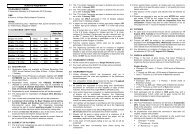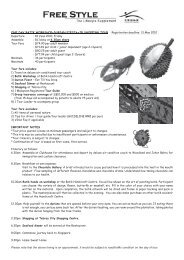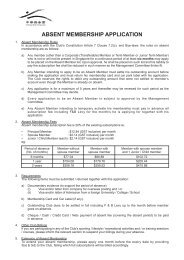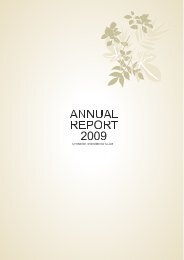eFreeStyle - Chinese Swimming Club
eFreeStyle - Chinese Swimming Club
eFreeStyle - Chinese Swimming Club
You also want an ePaper? Increase the reach of your titles
YUMPU automatically turns print PDFs into web optimized ePapers that Google loves.
GO GREEN<br />
CARE<br />
FOR OUR<br />
EARTH<br />
The Bleak Future of<br />
Endangered Species<br />
Endangerment is a becoming issue throughout the world.<br />
Although some measures are being taken to help specific<br />
cases of endangerment, the universal problem cannot be<br />
solved until humans protect the natural environments where<br />
endangered species dwell.<br />
Habitat destruction and overexploitation are often the<br />
primary causes for endangered species. Our planet is<br />
continually changing, causing habitats to be altered and<br />
modified. When changes occur at a fast pace, there is little<br />
or no time for individual species to react and adjust to new<br />
circumstances. This can create disastrous results. It may take<br />
centuries to re-grow a forest that was cut down by humans<br />
or destroyed by fire, and many of the world’s severely<br />
threatened animals and plants live in these forests. If the<br />
current rate of forest loss continues, huge quantities of plant<br />
and animal species will disappear.<br />
Due to the trade in animal parts, many species continue<br />
to suffer high rates of exploitation. Unrestricted whaling<br />
during the 20th century is an example of overexploitation,<br />
and the whaling industry brought many species of whales<br />
to extremely low population sizes.<br />
Among other factors are disease, pollution, and limited<br />
distribution (a consequence of other threats) that threaten<br />
various plant and animal species. Often, human activities lie<br />
at the root of most causes of endangerment.<br />
Why Save Endangered Species?<br />
Plants and animals hold medicinal, agricultural, ecological, commercial and aesthetic/recreational value. Endangered species<br />
must be protected and saved so that future generations can experience their presence and value.<br />
Protect Endangered Species For Our Next Generation<br />
Every one of us is part of this world, if we start doing something today, it will all add up! Here are some things you<br />
can do:<br />
1. Do not pour paint or chemicals into the ground or into the gutter. If you do, it will get into the water we drink, and<br />
into the lakes and oceans where it may harm the animals that live in the water and on the shore.<br />
2. Make a compost heap and let worms eat your garbage! Use it to feed your plants instead of chemical fertilizers.<br />
3. Reduce, reuse and recycle! Try to reduce the amount of garbage you throw away. Recycle paper, cardboard, cans, bottles<br />
and plastic. Buy things that don’t come packed in lots of cardboard and plastic; buy bigger quantities – it is cheaper<br />
and there’s less packaging.<br />
Identify The Endangered Species<br />
Out of the 15 species listed below, 12 are in immediate danger of becoming extinct. Identify them. Answers will be published<br />
in the next issue.<br />
Chimpanzee Dolphin Elephant Gorilla Green Pitcher Plant<br />
Siberian Tiger Marine Turtle Whale<br />
Orangutan Giant Panda Polar Bear Rhino Strangler Fig<br />
Giraffe<br />
Wild Boar<br />
Reference : Suzuki, David, and Boyd, David R. David Suzuki’s Green Guide. Vancouver: Greystone Books, 2008.<br />
www.endangeredspecie.com<br />
15

















